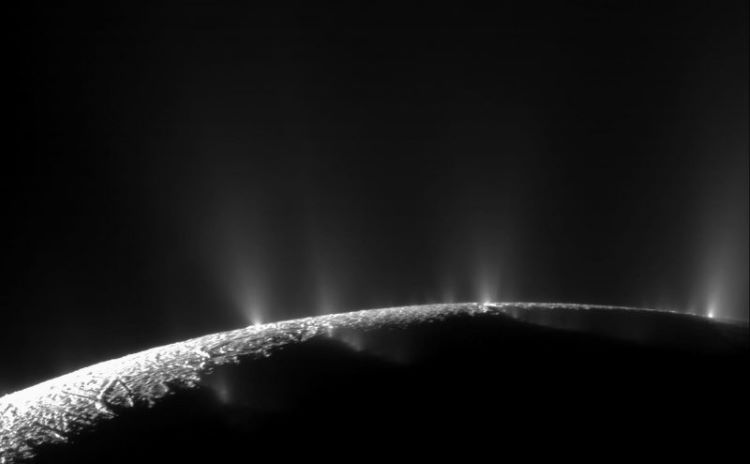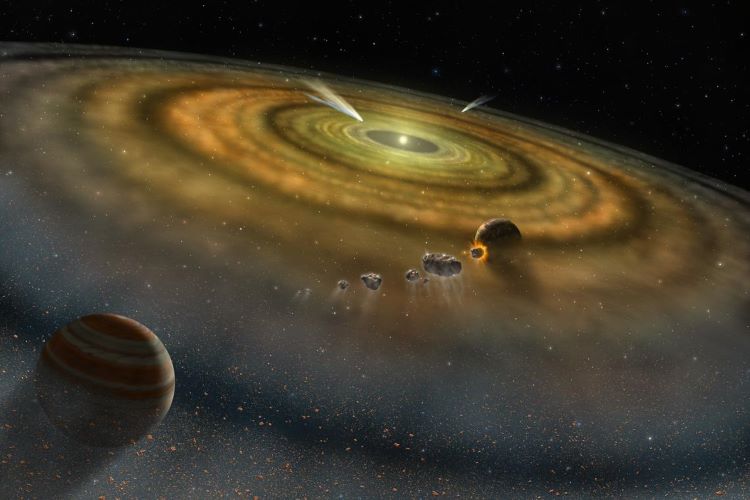Universe Today has had some fantastic discussions with researchers on the importance of studying impact craters, planetary surfaces, exoplanets, astrobiology, solar physics, comets, planetary atmospheres, and planetary geophysics, and how these diverse scientific fields can help researchers and the public better understand the search for life beyond Earth. Here, we will investigate the unique field of cosmochemistry and how it provides researchers with the knowledge pertaining to both our solar system and beyond, including the benefits and challenges, finding life beyond Earth, and suggestive paths for upcoming students who wish to pursue studying cosmochemistry. But what is cosmochemistry and why is it so important to study it?
“Cosmochemistry is the study of space stuff, the actual materials that make up planets, stars, satellites, comets, and asteroids,” Dr. Ryan Ogliore, who is an associate professor of physics at Washington University in St. Louis, tells Universe Today. “This stuff can take all the forms of matter: solid, liquid, gas, and plasma. Cosmochemistry is different from astronomy which is primarily concerned with the study of light that interacts with this stuff. There are two main benefits of studying actual astromaterials: 1) the materials record the conditions at the time and place where they formed, allowing us to look into the deep past; and 2) laboratory measurements of materials are extraordinarily precise and sensitive, and continue to improve as technology improves.”
In a nutshell, the field of cosmochemistry, also known as chemical cosmology, perfectly sums up Carl Sagan’s famous quote, “The cosmos is within us. We are made of star-stuff. We are a way for the cosmos to know itself.” To understand cosmochemistry is to understand how the Earth got here, how we got here, and possibly how life got wherever we’re (hopefully) going to find it, someday.
Like all scientific fields, cosmochemistry incorporates a myriad of methods and strategies with the goal of answering some of the universe’s most difficult questions, specifically pertaining to how the countless stellar and planetary objects throughout the universe came to be. These methods and strategies primarily include laboratory analyses of meteorites and other physical samples brought back from space, including from the Moon, asteroids, and comets. But what are some of the benefits and challenges of studying cosmochemistry?
“One of the primary benefits of cosmochemistry is the ability to reproduce measurements,” Dr. Ogliore tells Universe Today. “I can measure something in my lab, and somebody else can measure either the same object, or a very similar object, in another lab to confirm my measurements. Only after repeated measurements, by different labs and different techniques, will a given claim be universally accepted by the community. This is difficult to do in astronomy, and also difficult using remote-sensing measurements on spacecraft studying other bodies in the Solar System.”
Apart from the crewed Apollo missions to the Moon, all other samples from space have been returned via robotic spacecraft. While this might seem like an easy process from an outside perspective, collecting samples from space and returning them to Earth is a very daunting and time-consuming series of countless tests, procedures, precise calculations, and hundreds to thousands of scientists and engineers ensuring every little detail is covered to ensure complete mission success, often to only collect a few ounces of material. This massive effort is tasked with not only ensuring successful sample collection, but also ensuring successful storage of the samples to avoid contamination during their journey home, and then retrieving the samples once they land in a capsule back on Earth, where they are properly unpacked, cataloged, and stored for laboratory analysis.
To demonstrate the difficulty in conducting a sample return mission, only four nations have successfully used robotic explorers to collect samples from another planetary body and returned them to Earth: the former Soviet Union, United States, Japan, and China. The former Soviet Union successfully returned lunar samples to Earth throughout the 1970s; the United States has returned samples from a comet, asteroid, and even solar particles; Japan has successfully returned samples from two asteroids; and most recently, China succeeded in returning 61.1 ounces from the Moon, which is the current record for robotic sample return missions. But even with the difficulty of conducting a successful sample return mission, what can cosmochemistry teach us about finding life beyond Earth?
“Cosmochemistry can tell us about the delivery of the ingredients necessary for life to planets or moons via asteroids or comets,” Dr. Ogliore tells Universe Today. “Since we have both asteroid and comet material in the lab, we can tell if primitive pre-biotic organic compounds may have been delivered by these bodies. Of course, this doesn’t mean life on Earth (or elsewhere) started this way, only that it is one pathway. Detection of life on another world would be one of the biggest discoveries in the history of science. So of course we’d want to be absolutely sure! This requires repeated measurements by different labs using different techniques, which requires a sample on Earth. I think the only way we’d know for sure if there was life on Europa, Enceladus, or Mars is if we bring a sample back to Earth from these places.”
As it turns out, NASA is actively working on the Mars Sample Return (MSR) mission, for which Dr. Ogliore is a member of the MSR Measurement Definition Team. The goal of MSR will be to travel to the Red Planet to collect and return samples of Martian regolith to Earth for the first time in history. The first step of this mission is currently being accomplished by NASA’s Perseverance rover in Jezero Crater, as it is slowly collecting samples and dropping them in tubes across the Martian surface for future retrieval by MSR.
For Europa, while there have been several discussions regarding a sample return mission, including a 2002 study discussing a sample return mission from Europa’s ocean and a 2015 study discussing a potential plume sample return mission, no definitive sample return missions from Europa are currently in the works, possibly due to the enormous distance. Despite this, and while not a life-finding mission, Dr. Ogliore has been tasked to lead a robotic mission to Jupiter’s volcanic moon, Io, to explore its plethora of volcanoes. For Enceladus, the Life Investigation for Enceladus (LIFE) mission has had a number of mission proposals submitted to return samples from Enceladus’ plumes, though it has yet to be accepted. But what is the most exciting aspect about cosmochemistry that Dr. Ogliore has studied during his career?

“In my opinion the most important single measurement in the history of cosmochemistry was the measurements of the oxygen isotopic composition of the Sun,” Dr. Ogliore tells Universe Today. “To do this, we needed to return samples of the solar wind to Earth, which we did with NASA’s Genesis mission. However, the sample return capsule crashed on Earth. But did that stop the cosmochemists?! Hell no! Kevin McKeegan and colleagues at UCLA had built a specialized, enormous, complicated instrument to study these samples. Despite the crash, McKeegan and colleagues analyzed oxygen in the solar wind and found that it was 6% lighter than oxygen found on Earth, and it matched the composition of the oldest known objects in the Solar System: millimeter-sized calcium-aluminum inclusions (CAIs) found in meteorites.”
Dr. Ogliore continues by telling Universe Today about how this result was predicted by Bob Clayton at the University of Chicago, along with crediting his own postdoc, Lionel Vacher, for conducting a research project that built off the Genesis results, noting, “This was a really fun project because it was technically very challenging, and the results put the Solar System in its astrophysical context.”
Like the myriad of scientific disciplines that Universe Today has examined during this series, cosmochemistry is successful due to its multidisciplinary nature that contributes to the goal of answering some of the universe’s most difficult questions. Dr. Ogliore emphasizes that analysis of laboratory samples involves a multitude of scientific backgrounds to understand what the researchers are observing within each sample and the processes responsible for creating them. Additionally, this also includes the aforementioned sample return missions and hundreds to thousands of scientists and engineers who partake in each mission. Therefore, what advice can Dr. Ogliore offer to upcoming students who wish to pursue cosmochemistry?
“Biology, chemistry, geology, physics, math, electronics — you need it all!” Dr. Ogliore tells Universe Today. “If you like learning new things constantly, then planetary science is for you. It is good to get a very broad education. This will serve you well in a number of careers, but it is especially true for planetary science and cosmochemistry. I get to work with people who study volcanoes, and mathematicians working on chaotic motion. How cool is that?!”
All things considered, cosmochemistry is both an enormously challenging and rewarding field of study to try and answer some of the most difficult and longstanding questions regarding the processes responsible for the existence of celestial bodies in the Solar System and beyond, including stars, planets, moons, meteorites, and comets, along with how life emerged on our small, blue world. As noted, cosmochemistry perfectly sums up Carl Sagan’s famous quote, “The cosmos is within us. We are made of star-stuff. We are a way for the cosmos to know itself.” It is through cosmochemistry and the analysis of meteorites and other returned samples that enable researchers to slowly inch our way to answering what makes life and where we can find it.
“Meteorites are the most spectacular record of nature known to mankind,” Dr. Ogliore tells Universe Today. “We have rocks from Mars, the Moon, volcanic worlds, asteroid Vesta, and dozens of other worlds. Iron meteorites are the cores of broken apart planets. These rocks record processes that occurred four and a half billion years ago and fall to Earth in a blazing fireball traveling at miles per second. You can follow various blogs that track fireballs, and even calculate areas where meteorites might have fallen. If you ever have the opportunity, go try to find one of these freshly fallen meteorites. The odds are long, but it is worth a try. I have not found a meteorite myself yet, but it is a life goal of mine.”
How will cosmochemistry help us better understand our place in the universe in the coming years and decades? Only time will tell, and this is why we science!
As always, keep doing science & keep looking up!

